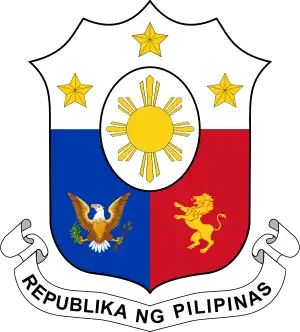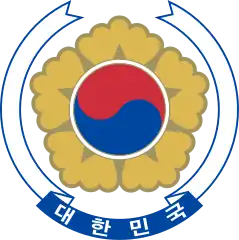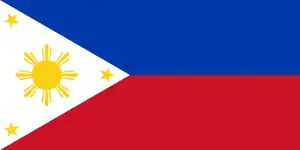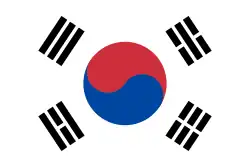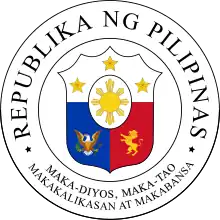Philippines–South Korea relations
The Philippines–South Korea relations (Korean: 대한민국-필리핀 공화국 관계; Hanja: 大韓民國-菲律賓 共和國 關係; RR: Daehan Minguk-Pillipin Gonghwaguk Gwangye; Filipino: Ugnayang Pilipinas at Timog Korea) refers to the bilateral relations between the Republic of the Philippines and the Republic of Korea. The Philippines has an embassy in Seoul, while South Korea has an embassy in Manila. The relationship between the Philippines and South Korea can be classified as strong as the two countries have historically been and continue to be close diplomatic and military allies. They are also significant economic partners in terms of trade, immigration, and tourism. They are both close allies of the United States.
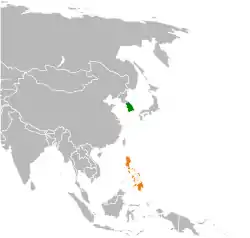 | |
South Korea |
Philippines |
|---|---|

History
Moon Soon-deuk, considered as Korea's first person to learn a Philippine language (i.e. the Ilocano language), was able to use his interpretation skills conversing with the five Filipinos who were shipwrecked off Jeju Island in 1801 and were able to return home after nine years. He was the first recorded Filipino interpreter in Joseon dynasty.[1]
Moon, a survivor of shipwreck himself, was a ray merchant who lived on Ui Island, drifted to Japan's Okinawa Island with his uncle and four other colleagues, and then ended up seeing the Philippines, Macao and China. They were hit by the typhoon while on their way home from another island nearby after purchasing some fish known as "hongeo". Moon had a flair with foreign languages as he acquired the language in Yeosong (Luzon) - possibly Ilocano language, and had a sharp eye for the way the people lived. He was able to describe the towns, churches, houses, and how people prepared food in the northern Luzon region.[2]
.jpg.webp)
During World War II, the Japanese forcefully imported Korean soldiers to the Philippines to serve Japan's occupation from 1944 until the end of the war. During this time, Koreans were branded as "more cruel than the Japanese", however, a study published in 2012 found these rumors to be baseless. Only 2 Korean soldiers were ever convicted of war crimes in the Philippines. The study notes that the rumors may have likely been spread by the Japanese throughout the islands to incur hate against ethnic Koreans during and after the war.[3] Bilateral relations between South Korea and the Philippines were established on March 3, 1949 upon the recognition of Republic of Korea as a sovereign state by the Philippines. The Philippines was the fifth state to recognize the Republic of Korea and the first ASEAN country to establish relations with the new nation.[4][5] During the Korean War (1950-1953), the Philippines sent its forces to aid South Korea. It was the first Asian country to respond to the call of the United Nations (UN) to help South Korea when it was invaded by Chinese and North Korean communist forces.[6][7]
As of 2009, there were 45,000 Filipinos residing in South Korea.[8] In 2011, the South Korean Ministry of Foreign Affairs and Trade conducted a census and found that there were more than 90,000 South Koreans living in the Philippines, a fall of 16% from 2009 after a period of rapid growth in the population in the preceding decade.[9][10][11] In 2017, civilian groups in the Philippines and South Korea joined forces to push for the inscription of Voices of the ”Comfort Women” in the UNESCO Memory of the World Programme. The inscription, however, was blocked by Japan.[12]
Economic relations
South Korea is the sixth biggest trading partner of the Philippines, while the Philippines is the third most attractive Southeast Asian country for South Korean investors in 2011.[13] South Korea also provides the biggest tourist market for the Philippines. In 2011, Koreans topped the list of tourists in the Philippines, followed by Japanese and Americans.[14]
Military relations
.jpg.webp)
Military relations between the two countries started during the Korean War when the Philippine government sent troops to enforce the United Nations campaign against the communist coalition of North Korea and China.
South Korea is an active arms donor and supplier for the Armed Forces of the Philippines.
They have donated numerous military hardware to the Philippines in the past, such as a number of F-5A/B fighter jets for the Philippine Air Force. These planes have since been decommissioned, but not before seeing ample use in the latter's domestic military operations against communist and Muslim separatist insurgents. In addition to this, South Korea had also donated a number of T-41 trainer planes.
In 2014, South Korea donated the ROKS Chungju, a Pohang-class corvette, to the Philippine Navy. She was handed over, refitted, and commissioned as the BRP Conrado Yap (PS-39) on August 5, 2019.[15][16]
The South Korean government also actively fulfills contracts for the Philippines for a variety of military hardware. These range from small arms, armored tactical vehicles, missile frigates, to multirole fighters.
In 2017, South Korea delivered the last batch of the 12 FA-50 Fighting Eagle light fighter jets ordered by the Philippines.[17]
On October 16, 2018, Hyundai Heavy Industries laid down and began construction on BRP Jose Rizal (FF-150), the first missile frigate of her class and one of two that had been placed on order by the Philippine government. She was launched on May 23, 2019 and commissioned in May of the following year. Laying down and construction of the next missile frigate, BRP Antonio Luna (FF-151), also began on May 23, 2019. She was launched on November 8, 2019 and commissioned on March 19, 2021.[18][19]
Controversies
In 2012, the first naturalized Korean lawmaker with Filipino descent received backlash from racist and xenophobic Korean netizens. The attacks were focused on the lawmaker's Filipino ethnic background.[20] In 2016, a South Korean businessman was kidnapped and killed by rogue cops in the Philippines who accused him of being involved in the illegal drug trade.[21][22][23] The Philippine government has apologized for the incident.[24] In July 2020, a Philippine envoy resigned after allegedly sexually harassing a Korean woman in 2019.[25] In September 2020, online conflict sparked between the two nations over Korean racism against Filipinos. A Filipino wore clothing which looked like the Japanese rising sun. This angered many Koreans due to South Korea's history with Japan. Korean users spouted racist remarks over the skin color and other physical attributes of indigenous Filipinos.[26]
Country comparison
See also
References
- "Festival on Korean shipwreck survivor opens to promote East Asia peace".
- "[카드뉴스] 홍어장수 '문순득 표류기'...흑산도에서 필리핀까지". September 2017.
- Jose, Lydia N. Yu (2012). "The Koreans in Second World War Philippines: Rumour and history". Journal of Southeast Asian Studies. Cambridge University Press. 43 (2): 324–339. doi:10.1017/S0022463412000082. JSTOR 41490327. S2CID 159881048. Retrieved 17 August 2021.
- "Philippines-South Korea Relations". Philippine Embassy. Retrieved 10 June 2013.
- "Korea, Philippines move toward deeper cooperation". www.korea.net. Archived from the original on 2013-10-20.
- "SoKor thanks anew PH military assistance in Korean War". Philippine News Agency. Retrieved 15 August 2021.
- "South Korea honors Filipinos who fought in Korean War on 70th anniversary". ABS-CBN News. Retrieved 15 August 2021.
- 체류외국인 국적별 현황, K2WebWizard 2009년도 출입국통계연보, South Korea: Ministry of Justice, 2009, p. 262, retrieved 21 March 2011
- 재외동포 본문(지역별 상세), Ministry of Foreign Affairs and Trade, 15 July 2011, p. 104, retrieved 25 February 2012
- 재외동포현황, South Korea: Ministry of Foreign Affairs and Trade, 2009, retrieved 21 May 2009
- Meinardus, Ronaldo (15 December 2005), ""Korean Wave" in Philippines", The Korea Times, archived from the original on 13 January 2006, retrieved 16 February 2007
- "Voices of the "Comfort Women": The Power Politics Surrounding the UNESCO Documentary Heritage". The Asia-Pacific Journal Japan Focus. Retrieved 17 August 2021.
- "PH seeks deeper trade ties with South Korea". The Manila Times. 27 September 2012. Archived from the original on 8 October 2012. Retrieved 20 March 2013.
- Chua, Ryan (27 December 2012). "PH welcomes 1 millionth Korean visitor this year". ABS-CBN News. ABS-CBN Corporation. Retrieved 10 June 2013.
- Agence France Press. "South Korea Is Giving The Philippine Navy A Free Ship As Tensions Rise With China". Insider Inc. Retrieved 28 April 2020.
- Nepomuceno, Priam (6 August 2019). "PH Navy commissions first modern corvette into fleet". Philippine News Agency. Retrieved 28 April 2020.
- "PH Air Force to complete acquisition of 12 FA-50 fighter jets in May". Rappler. 8 April 2017. Retrieved 28 April 2020.
- "FF-150 BRP Jose Rizal – Frigate Acquisition Project". GlobalSecurity.org. Retrieved 28 April 2020.
- "Navy commissions second missile-capable frigate BRP Antonio Luna". GMA News. Retrieved August 9, 2022.
- "Jasmine Lee faces 'racist' attacks from Korean netizens". ABS-CBN News. April 17, 2012.
- Placido, Dharel (2017-01-20). "'Tokhang-for-ransom': Timeline of South Korean businessman's abduction, killing". ABS-CBN News. Retrieved 2021-07-06.
- Placido, Dharel (2017-01-26). "Duterte apologizes for Korean's killing". ABS-CBN News. Retrieved 2021-07-06.
- Esguerra, Christian V. (2017-01-26). "South Korea accepts Duterte apology, seeks speedy probe". ABS-CBN News. Retrieved 2021-07-06.
- Gonzales, Yuji Vincent (2017-02-06). "Korean gov't accepts PH's apology over Jee Ick-joo's death—Panelo". INQUIRER.net. Retrieved 2021-07-06.
- "Philippine envoy to Seoul resigns over sexual harassment case". koreatimes. July 18, 2020.
- "Filipinos angered by racist comments from internet users in Korea". Korea Times. September 9, 2020.
- The Speaker is required to not have membership of any political party during his or her tenure as Speaker, by law.
External links
 Media related to Relations of the Philippines and South Korea at Wikimedia Commons
Media related to Relations of the Philippines and South Korea at Wikimedia Commons
.jpg.webp)
